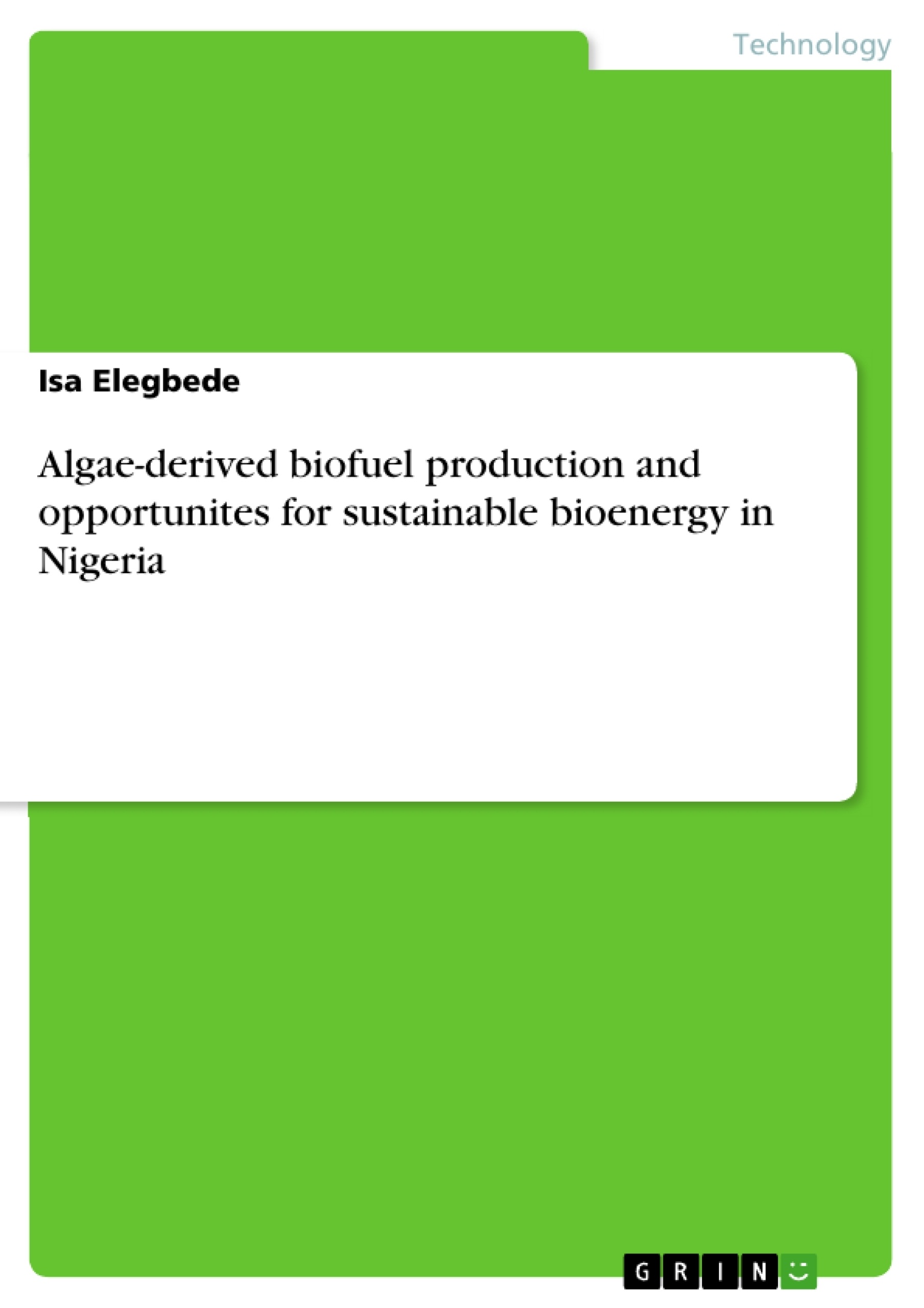This paper deals with the use of algae in the creation of biofuels as a form of renewable energy. Algae, a group of living organisms uniquely adapted to aquatic environment; they exhibit conversion ability of radiation energy into carbon source aimed at reducing emission from conventional fuel. The most assured interest of algae as a biofuel agent is the abundance storage of lipid which is converted to various energy yields.
Civilization, urbanization and competition of tillage land with crops for production of bioenergy have been among the challenges facing the bioenergy sector. However, an excellent panacea is the cultivation of algae from waste, non-waste water or industrial waste water, which has been found to be a positive platform for algae-derived biofuel; numerous attempts have been made by so many nations to reduce carbon emissions; amongst are the developments of frameworks for the prospective utilization of renewable energy resources, due to its abundance and sustainability.
There is no gainsaying that countries in African are endowed with renewable energy resources, especially Nigeria. Lack of expertise, inadequate management and failure to adhere to policies has been a great challenge in actualizing the promising benefit of renewable energy and implementation in Nigeria.
According to Ladokun et al (2013), Nigeria is a tropical rich zone which lies between latitudes 4°N and 14°N and longitudes 2°2’E and 14°30’E, it occupies wide coverage of 923 770 km2. Owing to its hydrological potentials which are considered as great assets to the algae biofuel energy industry. The country is a coastal region with boundaries along the southern area by the Atlantic Ocean. The country’s north-south part extents to about 1 050 km and its east-west extent is about 1 150 km, which is bordered to the western part by Benin Republic, also to the northern region by Niger and Chad, also boarded in the eastern part by Cameroon.
Inhaltsverzeichnis (Table of Contents)
- CHAPTER ONE. INTRODUCTION.
- 1.1 Nigeria and Its Resplendent Energy Profile..
- 1.2 Kyoto protocol and the Nigerian renewable energy policies.......
- 1.3 Nigeria Action on Renewable energy
- 1.4 Renewable Energy in Nigeria .......
- 1.6 History of algae biofuel
- 1.6 Status of algae in biofuel generations.
- 1.7 Diversity and suitability of algae ..
- 1.8 Classifications of algae strains.
- 1.9 Biology and chemical compositions of algae.
- CHAPTER TWO. PRODUCTION OF ALGAE BIOMASS..
- 2.1 Open System
- 2.2 Closed Photobioreactors (PBR)..\li>
- 2.2.3 Types of photo bioreactor systems PBR
- 2.3 Heterotrophic Fermentation
- 2.4 Integrated Cultivation Systems .
- 2.4.1 Biofilm Processing...
- 2.4.3 Algal Turf Scrubbers (ATS).
- 2.5 Advanced Integrated Wastewater Pond System .....
- 2.6 Heterotrophic Fermenters
- 3 Processing of algae to biofuel.
- 3.1 Harvesting and moist removal.
- 3.2 Algal oil extraction..
- 3.3 Conversion of oil to algae derived biofuel..
- CHAPTER four. SUSTAINABILITY OF ALGAE DERIVED BIOFUEL
- 4.1 Element of algae derived sustainability
- 4.1.1 Energy protection.....
- 4.1.2 Economic Structure
- 4.1.3 Environmental and resource control.
- 4.1.4 Social affiliations.
- 4.2 Indicators...
- 4.3 Life-Cycle Assessment of Algae derived fuel..........\li>
- 4.4 Scenario Analysis..
- CHAPTER FIVE ECONOMIC IMPLICATIONS OF ALGAE BIOFUEL
- 5.1 Alternative revenues..
Zielsetzung und Themenschwerpunkte (Objectives and Key Themes)
This work explores the potential of algae-derived biofuel for a more sustainable energy future in Nigeria, highlighting the importance of this renewable resource within the context of the country's energy profile and the global shift towards sustainable bioenergy.
- The role of algae-derived biofuel in achieving sustainable energy goals in Nigeria.
- The technical aspects of algae biofuel production, including cultivation methods and biofuel conversion processes.
- Assessment of the economic and environmental feasibility of algae biofuel production in Nigeria.
- The societal and policy implications of promoting algae-derived bioenergy in Nigeria.
- Analysis of the sustainability of algae-derived biofuel production, considering energy, economic, environmental, and social aspects.
Zusammenfassung der Kapitel (Chapter Summaries)
Chapter One provides a background on Nigeria's energy landscape and explores the challenges and opportunities associated with transitioning to a more sustainable energy future. It also delves into the history and status of algae biofuel production. Chapter Two examines various methods for cultivating algae biomass, including open systems, closed photobioreactors, heterotrophic fermentation, and integrated cultivation systems. Chapter Three discusses the processing steps involved in converting algae biomass into biofuel, including harvesting, oil extraction, and biofuel conversion. Chapter Four analyzes the sustainability of algae-derived biofuel from an energy, economic, environmental, and social perspective. Chapter Five explores the economic implications of algae biofuel production in Nigeria, focusing on alternative revenue streams.
Schlüsselwörter (Keywords)
Algae biofuel, sustainable bioenergy, renewable energy, Nigeria, energy policy, cultivation methods, biofuel production, economic feasibility, environmental sustainability, social implications, life cycle assessment.
- Citar trabajo
- Isa Elegbede (Autor), 2016, Algae-derived biofuel production and opportunites for sustainable bioenergy in Nigeria, Múnich, GRIN Verlag, https://www.grin.com/document/312227



